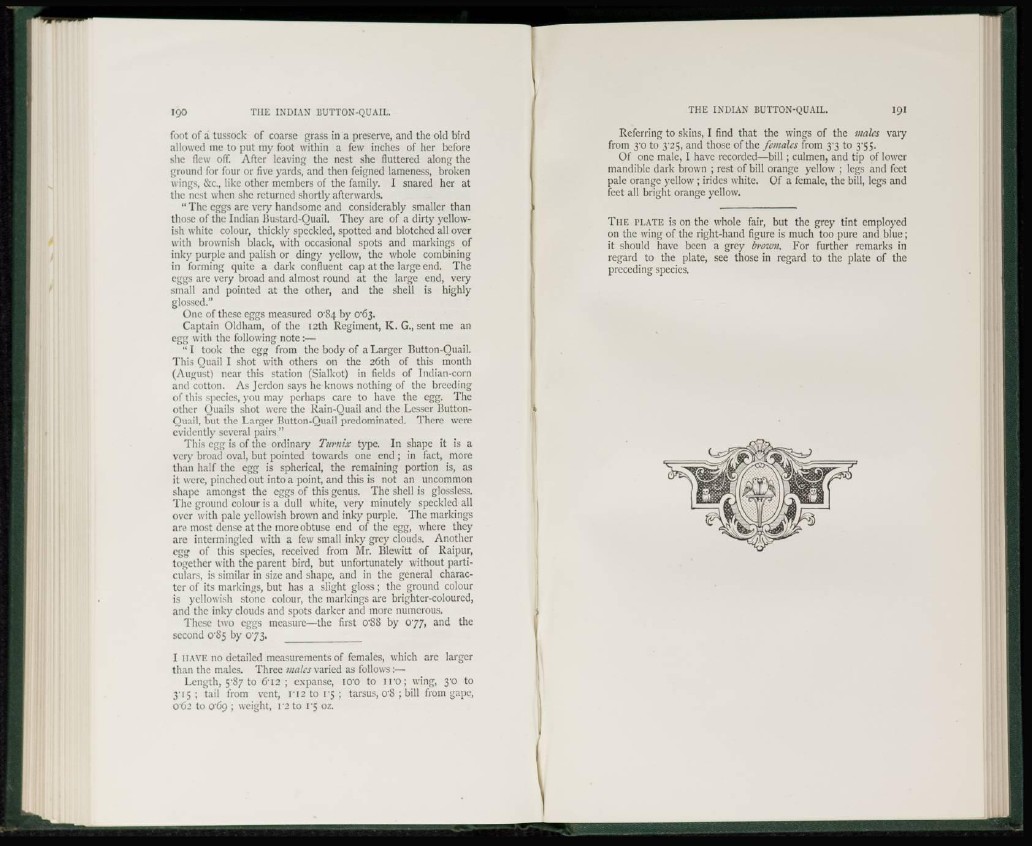
foot of a tussock of coarse grass in a preserve, and the old bird
allowed me to put my foot within a few inches of her before
she flew off. After leaving the nest she fluttered along the
ground for four or five yards, and then feigned lameness, broken
wings, &c, like other members of the family. I snared her at
the nest when she returned shortly afterwards.
"The eggs are very handsome and considerably smaller than
those of the Indian Bustard-Quail. They arc of a dirty yellowish
white colour, thickly speckled, spotted and blotched all over
with brownish black, with occasional spots and markings of
inky purple and palish or dingy yellow, the whole combining
in forming quite a dark confluent cap at the large end. The
eggs arc very broad and almost round at the large end, very
small and pointed at the other, and the shell is highly
glossed."
One of these eggs measured 0'S4 by 0*63.
Captain Oldham, of the 12th Regiment, K. G., sent me an
egg with the following note :—
" I took the egg from the body of a Larger Button-Quail.
This Quail I shot with others on the 26th of this month
(August) near this station (Sialkot) in fields of Indian-corn
and cotton. As Jcrdon says he knows nothing of the breeding
of this species, you may perhaps care to have the egg. The
other Quails shot were the Rain-Quail and the Lesser Button-
Quail, but the Larger Button-Quail predominated. There were
evidently several pairs "
This egg is of the ordinary Turnix type. In shape it is a
very broad oval, but pointed towards one end ; in fact, more
than half the egg is spherical, the remaining portion is, as
it were, pinched out into a point, and this is not an uncommon
shape amongst the eggs of this genus. The shell is glossless.
The ground colour is a dull white, very minutely speckled all
over with pale yellowish brown and inky purple. The markings
are most dense at the more obtuse end of the egg, where they
are intermingled with a few small inky grey clouds. Another
egg of this species, received from Mr. Blewitt of Raipur,
together with the parent bird, but unfortunately without particulars,
is similar in size and shape, and in the general character
of its markings, but has a slight gloss ; the ground colour
is yellowish stone colour, the markings are brighter-coloured,
and the inky clouds and spots darker and more numerous.
These two eggs measure—the first 0*88 by 077, and the
second O'Ss by 073.
I 11 AVE no detailed measurements of females, which are larger
than the males. Three males varied as follows:—
Length, 5-S7 to 6'i2 ; expanse, ico to i r o ; wing, 3X3 to
3-15 ; tail from vent, I T 2 to 1*5 ; tarsus, O'S ; bill from gape,
062 to 0"6o,; weight, 1*2 to 15 oz.
Referring to skins, I find that the wings of the males vary
from 3"0 to 3'25, and those of the females from 3'3 to
Of one male, I have recorded—bill ; culmen, and tip of lower
mandible dark brown ; rest of bill orange yellow ; legs and feet
pale orange yellow ; irides white. Of a female, the bill, legs and
feet all bright orange yellow.
T H E PLATE is on the whole fair, but the grey tint employed
on the wing of the right-hand figure is much too pure and blue;
it should have been a grey broivn. For further remarks in
regard to the plate, see those in regard to the plate of the
preceding species.